Hablemos del Bengalí
Las marcas de estilo salvaje y los impresionantes colores del Bengalí hacen que este gato destaque entre los demás felinos. Su exclusivo pelaje moteado o jaspeado es solo una de sus interesantes características, sin olvidar su confianza, su enorme curiosidad y su energía ininterrumpida. Por independiente que parezca, la raza Bengalí suele tener gran apego hacia los humanos, así que puedes esperar toneladas de afecto. Su desarrollo por parte de una criadora a principios de los años 60, al cruzar un gato atigrado doméstico con un gato leopardo asiático salvaje, explica las dos caras de la interesante personalidad del Bengalí, por no mencionar su aspecto indomable.
Nombre oficial: Bengalí
Otros nombres: Leopardo, Leo
Orígenes: Estados Unidos de América
Largo del pelo
1 out of 5Nivel de muda de pelo
1 out of 5Necesidad de aseo
2 out of 5Nivel de energía*
4 out of 5Tendencia a maullar
1 out of 5¿Mascota familiar?*
5 out of 5Convivencia con otras mascotas
4 out of 5¿Puede quedarse solo?*
2 out of 5Entorno (interior/exterior)
4 out of 5
| Macho | Hembra |
|---|---|
| Altura | Altura |
| 0 - 0 cm | 0 - 0 cm |
| Peso | Peso |
| 4 - 6 kg | 3 - 5 kg |
| Gatito en desarrollo | Adulto |
|---|---|
| De 4 a 12 meses | De 1 a 7 años |
| Maduro | Sénior |
| De 7 a 12 años | A partir de 12 años |
Largo del pelo
1 out of 5Nivel de muda de pelo
1 out of 5Necesidad de aseo
2 out of 5Nivel de energía*
4 out of 5Tendencia a maullar
1 out of 5¿Mascota familiar?*
5 out of 5Convivencia con otras mascotas
4 out of 5¿Puede quedarse solo?*
2 out of 5Entorno (interior/exterior)
4 out of 5
| Macho | Hembra |
|---|---|
| Altura | Altura |
| 0 - 0 cm | 0 - 0 cm |
| Peso | Peso |
| 4 - 6 kg | 3 - 5 kg |
| Gatito en desarrollo | Adulto |
|---|---|
| De 4 a 12 meses | De 1 a 7 años |
| Maduro | Sénior |
| De 7 a 12 años | A partir de 12 años |
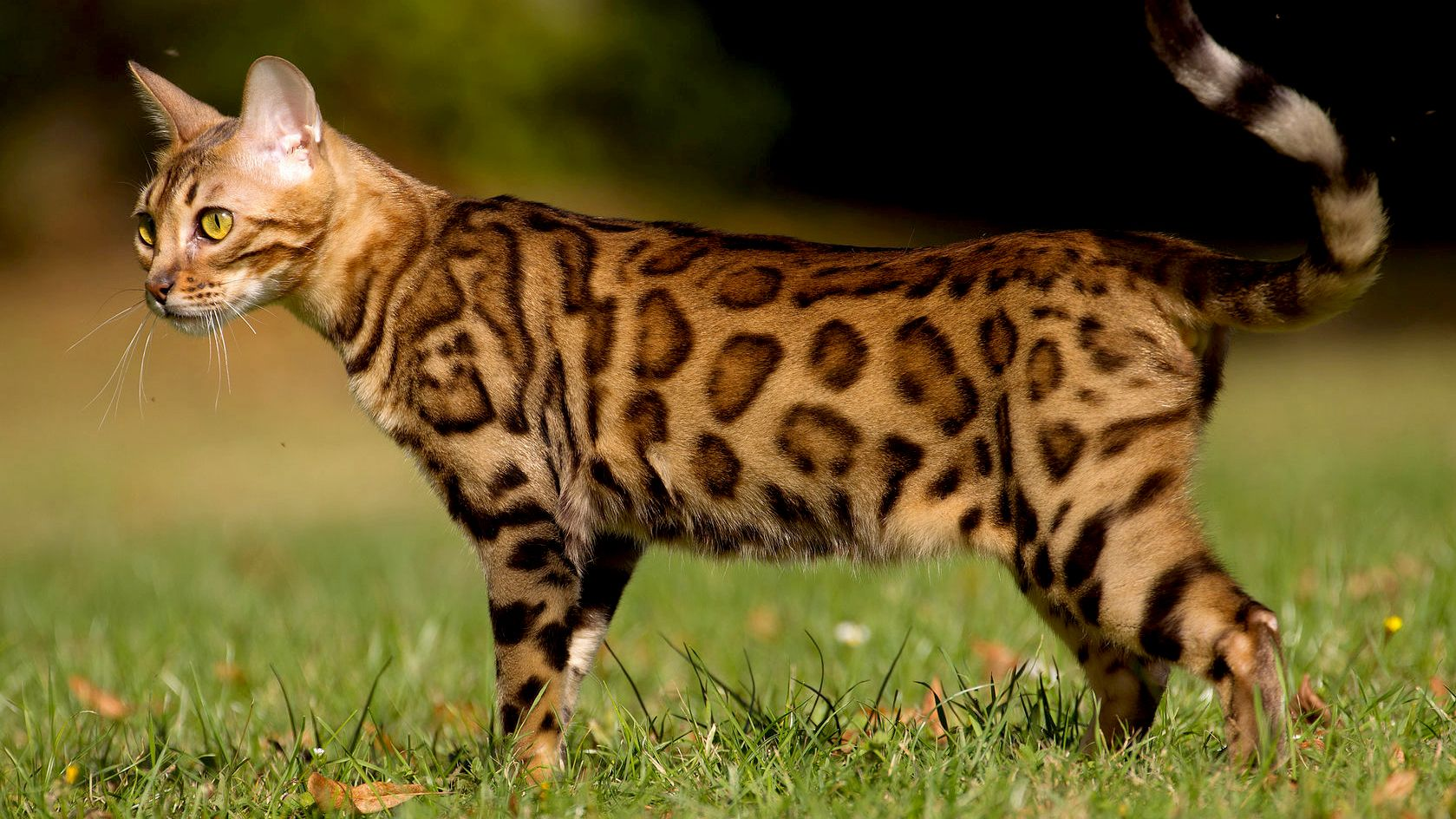
Conoce al Bengalí
Todo lo que necesitas saber sobre la raza
Si hay una raza que encarna el apodo de "gato curioso" es el Bengalí. Presenta una sensación de confianza, un deseo de salir y explorar su entorno doméstico y, con un animal tan brillante a tu alrededor, es fácil dejar que comience la aventura. Los Bengalíes tienen una valentía fascinante y no les importa la audiencia.
¿Lo mejor de tener un gato Bengalí a tu alrededor? Su fantástico y único pelaje en forma de roseta. El Bengalí es la única raza con estos diseños tan poco habituales que recuerdan a la forma de sus primos: el leopardo, el jaguar y el ocelote. El Bengalí de nieve es otra variación de la raza, que tiene una coloración excepcional mayoritariamente blanca. ¡Imagínate un leopardo de las nieves en miniatura! Se trata de un gen recesivo moteado que convierte el diseño blanco o marrón claro en un motivo único.
El pelaje de la raza Bengalí también puede ser jaspeado o moteado y su grosor afelpado es otro rasgo característico. Sea cual sea la forma, es increíble contemplarlo.
Si valoras tener un gato con una energía fuera de serie, esta es tu raza. De hecho, el Bengalí tiene alma de gatito incluso cuando alcanza una edad avanzada. El cruce único de gato doméstico con uno que tiene su hogar en la selva se hace evidente en este felino. Son extraordinariamente ágiles y atléticos, además de muy fuertes y elegantes. A la muy deseada raza Bengalí se le pueden aplicar palabras como magnífico, maravilloso y llamativo.
Curiosamente, el gato Bengalí se siente muy atraído por el agua, de modo que a veces entra en la ducha con los miembros de la familia o se queda mirando el agua que se utiliza para cocinar, bañarse, cepillarse los dientes o incluso simplemente lavarse las manos.
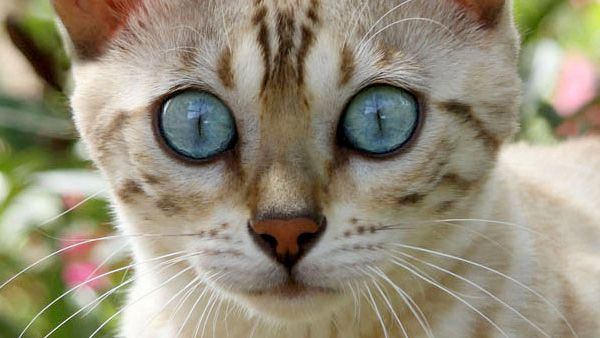
Dos datos sobre los Bengalíes
1. Alrededor de 1963
El gato Bengalí es una de las razas más recientes, ya que se desarrolló en 1963 y la International Cat Association le concedió el estatus de experimental en 1983. Más adelante se concedió a la raza el estatus completo en 1991.
2. Enséñale un par de trucos
No creas que solo los perros pueden aprender trucos: este gato tan inteligente también puede. El Bengalí puede aprender a sentarse, quedarse quieto, dar la pata e incluso tareas más complejas como buscar objetos. Se les da tan bien que pronto te preguntarás quién juega con quién...
Historia de la raza
El gato Bengalí toma su nombre del tigre de Bengala, ya que su pelaje se parece al de este primo lejano. A decir verdad, la raza doméstica desciende de la salvaje: el Bengalí entró en el dominio doméstico en 1963, después de ser desarrollado por Jean Mill, una entusiasta criadora de gatos de Arizona. Esta fanática de todo lo relacionado con los felinos cruzó un gato leopardo asiático con su propio gato negro. El resultado fue un Bengalí con un talante de gato doméstico y un atletismo similar al de un gato salvaje.
A continuación, Mill crió el primer gatito hembra y luego obtuvo camadas a partir de ahí. Más tarde, el Bengalí se desarrolló en la Universidad de California en Davis cuando Mill ayudó a criar ocho gatitos con un Burmese Abisinio y un Mau Egipcio.
En la actualidad, la raza Bengalí se ha domesticado mucho más pero también es una posesión preciada, conocida en los círculos felinos como el "Rolls Royce" de los gatos.
La International Cat Association adoptó la raza en 1983, pero solo le otorgó el estatus de experimental. El Bengalí recibió el estatus completo en 1991. La Federation Internationale Feline, una federación ampliamente elogiada de registros de gatos, lo reconoció como raza oficial en 1999.
De la cabeza a la cola
Características físicas del Bengalí
1.Orejas
2.Cabeza
3.Cuerpo
4.Cola
5.Pelaje
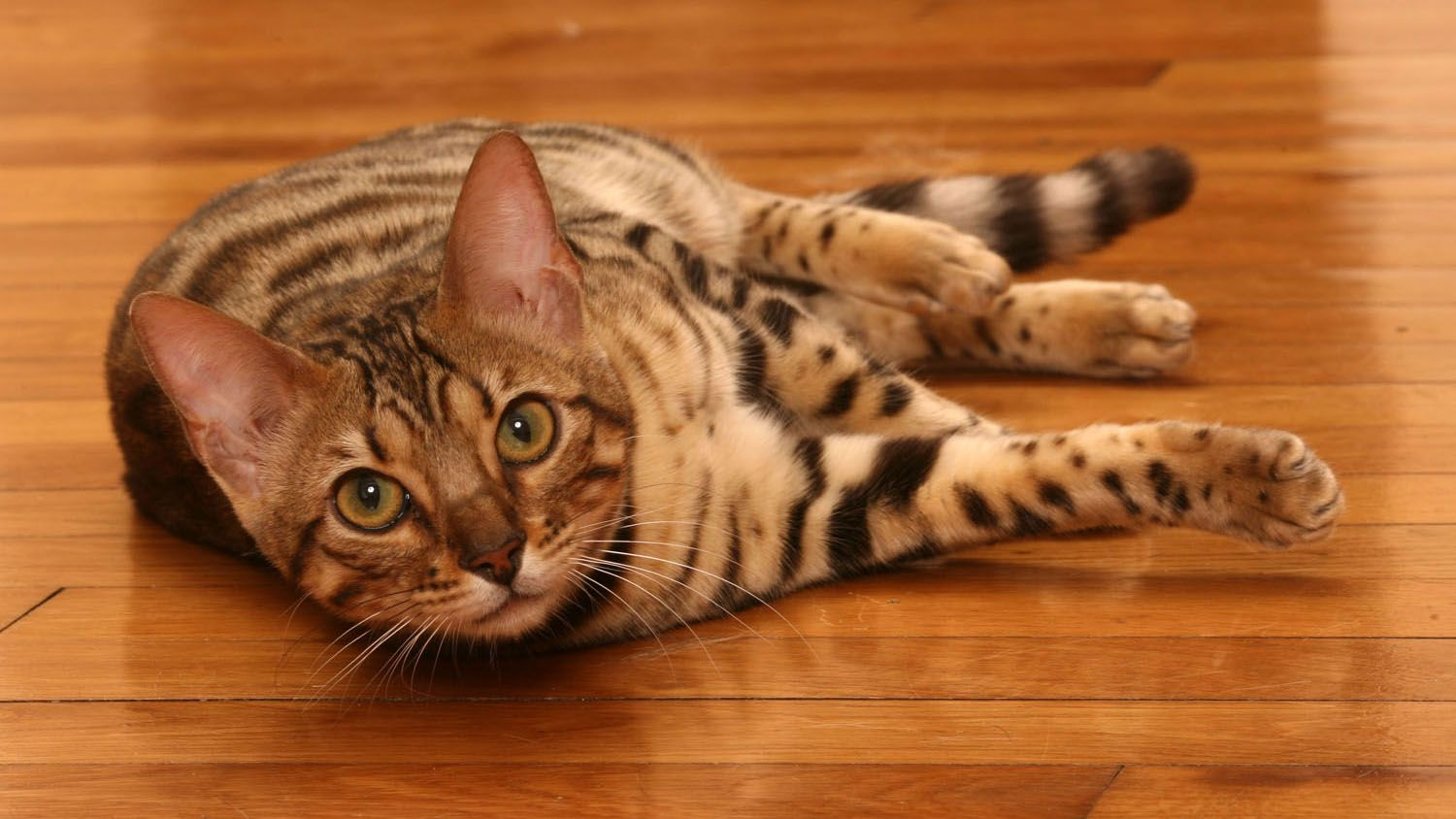
Aspectos que tener en cuenta
Desde rasgos específicos de la raza hasta una descripción general de su salud, aquí tienes algunos datos interesantes sobre tu Bengalí
Le gusta escalar, así que ten cuidado con tus lámparas más preciadas
Con la selva como hogar ancestral, puedes entender por qué los a Bengalíes les gusta escalar lo más alto posible: a menudo hasta el punto más alto de la casa. Es una buena idea guardar las reliquias familiares, la iluminación costosa y vigilar el mobiliario valioso. El carácter atlético y la valentía figuran entre los sorprendentes rasgos del Bengalí. La mejor parte: sus hábiles patas capaces de realizar muchas tareas complejas. ¡Se ha visto al Bengalí encendiendo y apagando los interruptores de la luz!
Cobayas del mundo, ¡uníos!
A pesar de ser una gran mascota familiar, la raza Bengalí tiene un instinto de caza muy desarrollado. Ten en cuenta que esta es solo la cuarta generación desde que se creó la raza. Por tanto, está a cuatro pasos de la naturaleza. Cuando se dio a conocer la raza (y se hizo más popular) a finales de los años 90, los futuros propietarios debían obtener una licencia o permiso para poseer un Bengalí. La tendencia a ir a buscar su propia cena todavía persiste. Mantén al gato lejos de pequeñas mascotas que vivan en la misma casa, como jerbos, ratones o cobayas, por si a tu gato se le ocurre alguna idea. También debes saber que tu Bengalí tiene patas hábiles que pueden realizar numerosas tareas, como levantar tapas y recoger objetos.
No será necesario contar tanto las calorías.
El peso nunca será un problema para la raza Bengalí. Su alta tasa de actividad y su forma de tomarse la vida sin parar ni un segundo les permite quemar calorías más rápido que una supermodelo durante la semana de la moda, y eso sin tener en cuenta su curiosidad inagotable. El mejor alimento para gatos Bengalíes es de alta calidad, con los nutrientes y minerales esenciales que necesitan para desarrollarse mejor a medida que crecen. Dado que los gatos necesitan comer poco y con frecuencia, divide la alimentación en varias comidas al día después de medir con cuidado la cantidad permitida. No alimentes en exceso a tu Bengalí para mantener su físico elegante.
Dieta saludable, gato más saludable
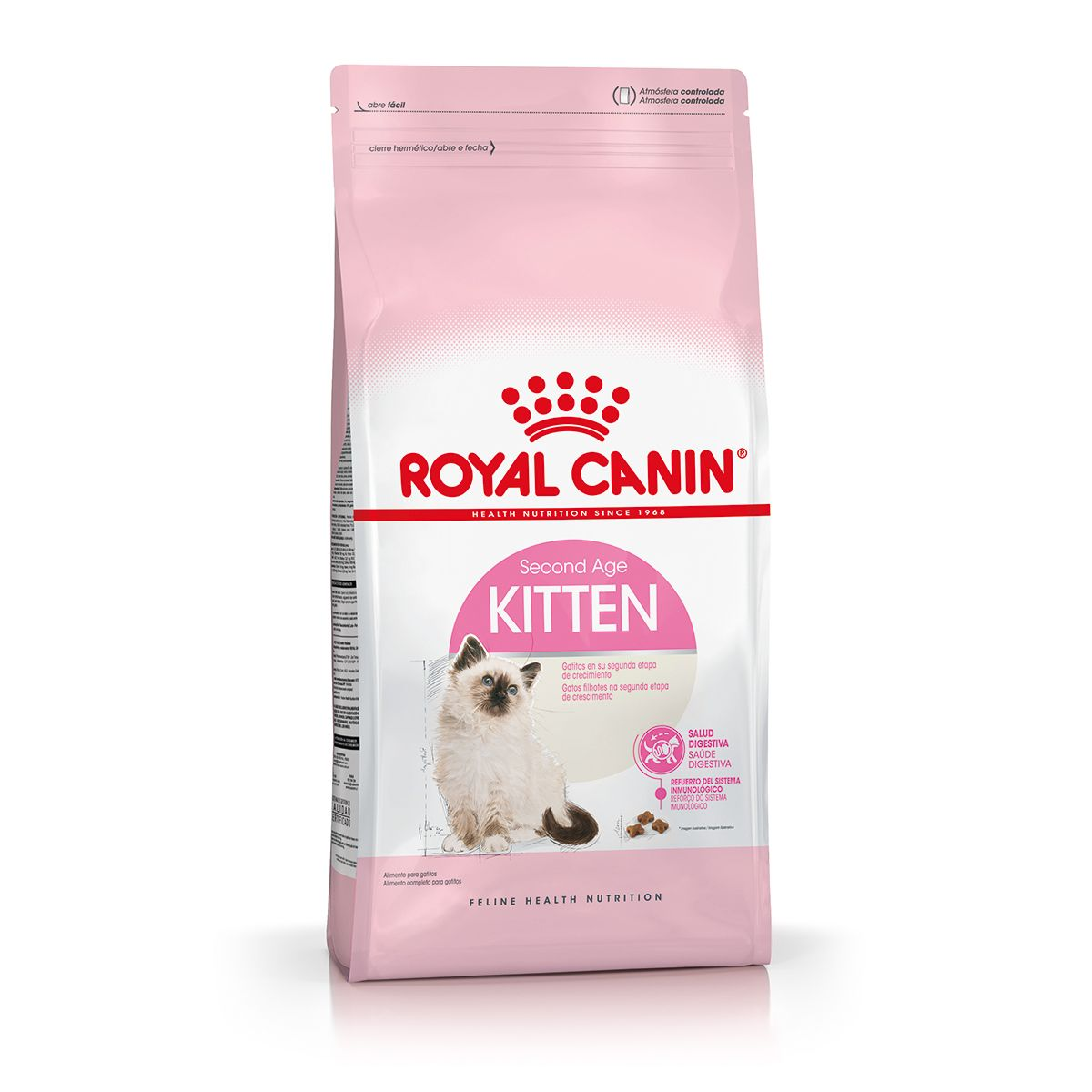
Una nutrición saludable a medida desempeña un papel fundamental en el mantenimiento de la salud y la belleza de un gato Bengalí. La comida proporciona energía para ayudar con las funciones vitales, y una fórmula nutricional completa para gatos Bengalíes debe contener un equilibrio adecuado de nutrientes. Alimentarles de este modo les ofrecerá una dieta que no peque ni por exceso ni por defecto y que, por tanto, no tenga efectos adversos sobre la salud de tu gato. Conviene que haya disponible agua limpia y fresca en todo momento para respaldar una buena regularidad urinaria. Los gatos también están adaptados de forma natural a comer porciones pequeñas entre 7 y 10 veces al día. Proporcionar la ración diaria recomendada de croquetas una vez al día permitirá a tu gato Bengalí regular su propio consumo. Las siguientes recomendaciones son para animales con buena salud. Si tu gato tiene problemas de salud, consulta al veterinario que recetará una dieta veterinaria exclusiva.
El crecimiento es una etapa esencial en la vida de cualquier gatito. Es una época de grandes cambios, descubrimientos y nuevos encuentros. Las necesidades de un gatito Bengalí en términos de energía, proteínas, minerales y vitaminas son mucho mayores que las de un adulto. Necesitan energía y nutrientes para mantener su cuerpo, pero también para crecer y desarrollarse. El crecimiento de un gatito consta de dos fases:
Construcción
Del nacimiento hasta los 4 meses
El destete es la transición que hace un gatito del alimento líquido, o leche materna, al alimento sólido. Este período corresponde de manera natural al momento en que les salen los dientes de leche, cuando tienen entre 3 y 6 semanas. En esta etapa, los gatitos aún no pueden masticar, por lo que una comida blanda (croqueta rehidratada o un alimento húmedo adaptado) ayuda a facilitar la transición de líquidos a sólidos.
Entre 4 y 12 semanas después del nacimiento
La inmunidad natural que recibe un gatito del calostro de la madre (la primera leche) disminuye, mientras que el sistema inmunológico del gatito se va desarrollando de forma gradual. Este momento crítico, llamado vacío inmunitario, requiere un complejo de antioxidantes, incluida la vitamina E, para ayudar a respaldar sus defensas naturales. Los gatitos pasan por un periodo intenso y particularmente delicado de crecimiento durante el cual son propensos a sufrir trastornos digestivos. Su dieta en este momento no solo debe ser rica en energía para satisfacer sus necesidades esenciales de crecimiento, sino que también debe contener proteínas altamente digeribles para satisfacer su sistema digestivo, que aún está madurando. Los prebióticos, como los fructooligosacáridos, también pueden respaldar su salud digestiva al ayudar a equilibrar la flora intestinal. ¿El resultado? Una buena calidad de las heces, en todos los aspectos. La alimentación del gatito debería contener ácidos grasos omega 3, EPA-DHA, que respaldan el correcto desarrollo neurocerebral.
Consolidación y armonización: de los 4 a los 12 meses
A partir del cuarto mes, el crecimiento de un gatito se ralentiza, por lo que se recomienda un alimento bajo en grasas. Esto es especialmente importante después de esterilizar al gato. Entre los 4 y los 7 meses, los dientes de leche del gatito se caen y se sustituyen por los permanentes. Cuando han salido los dientes de adulto, el gatito necesita comer croquetas que sean lo suficientemente grandes como para animarse a masticar. Hasta los 12 meses de edad, el sistema inmunológico de los gatitos Bengalíes todavía se está desarrollando de forma gradual. Un complejo de antioxidantes, incluida la vitamina E, puede ayudar a respaldar sus defensas naturales durante esta época de grandes cambios, descubrimientos y nuevos encuentros. El sistema digestivo va madurando progresivamente y las aptitudes digestivas alcanzan la plena madurez hacia los doce meses de edad. Es entonces cuando un gato Bengalí puede consumir comida de adulto.
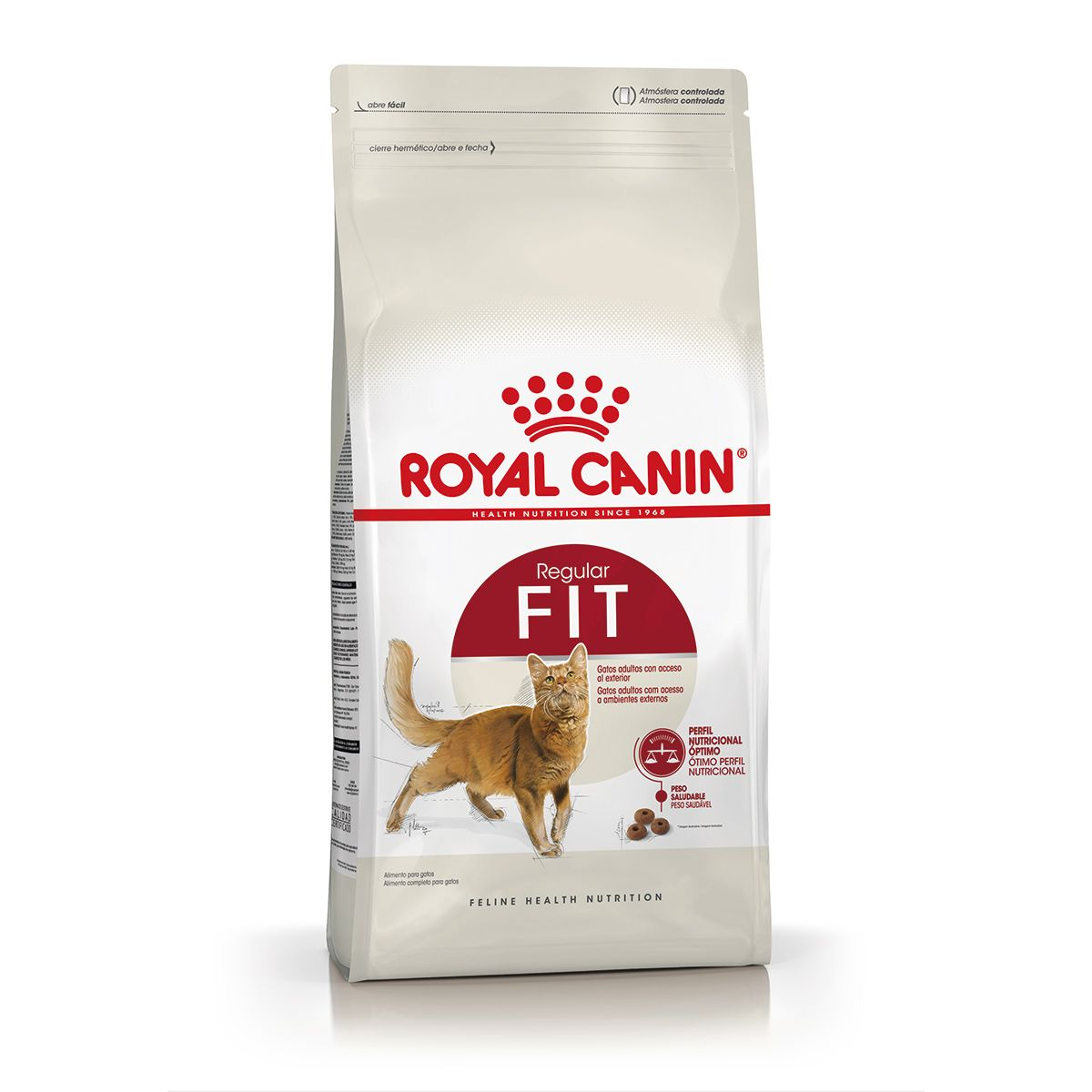
Además de mantener una función urinaria saludable como con el resto de gatos, los principales objetivos nutricionales para los Bengalíes adultos son:
Contribuir a mantener una masa muscular óptima para este gato tan alegre mediante proteínas de alta calidad y un contenido moderado en grasas.
Apoyar una digestión óptima y equilibrar la flora intestinal mediante el uso de proteínas y prebióticos altamente digeribles.
Ayudar a preservar la salud y la belleza de su piel y su pelo corto y lustroso enriqueciendo los alimentos con nutrientes específicos como aminoácidos específicos, vitaminas y ácidos grasos omega-3 y omega-6
Respaldar una buena higiene oral gracias a una forma de croqueta fácil de agarrar y una textura que les anime a masticar.
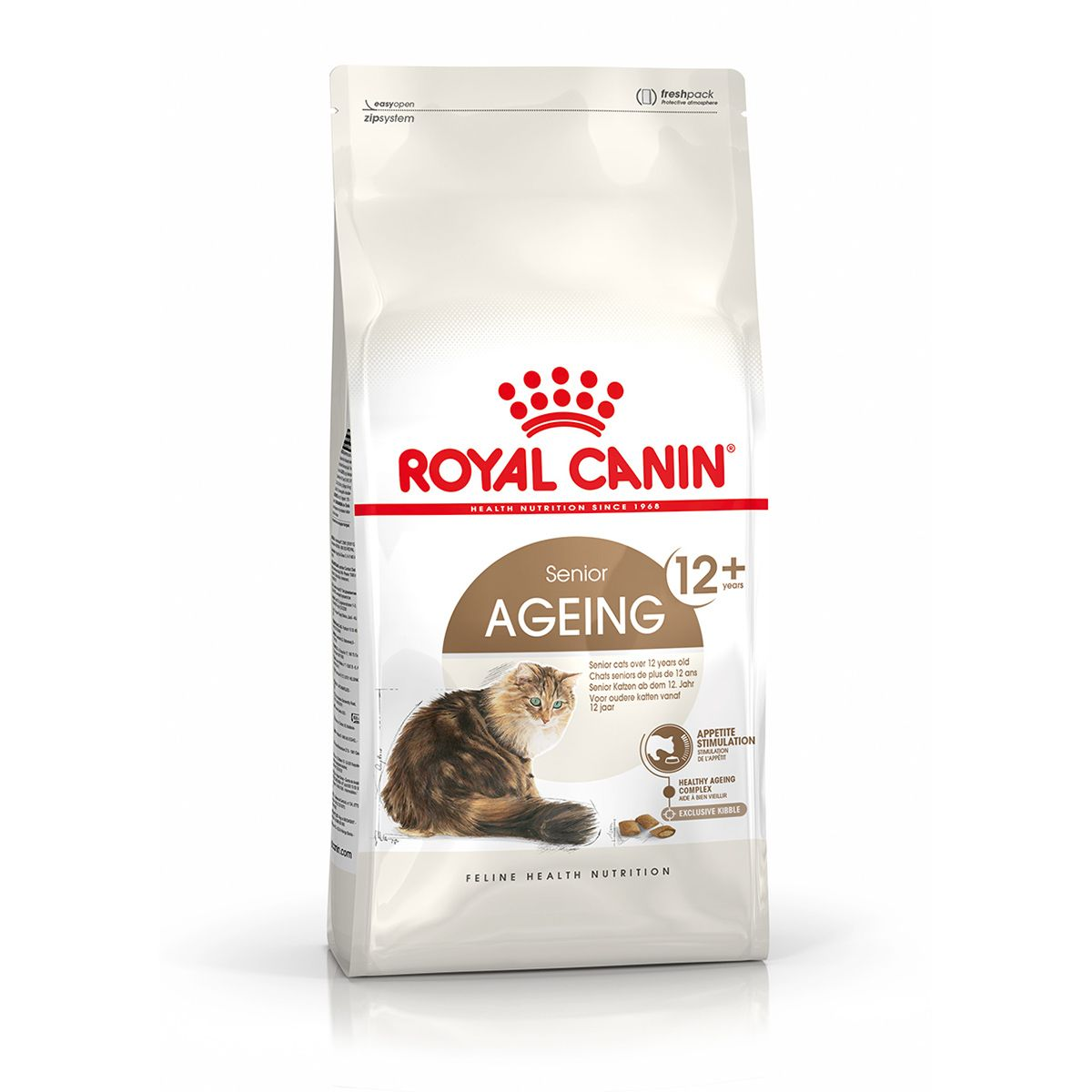
Un gato sénior, uno mayor de 12 años, a veces puede tener dificultades con la absorción. Para mantener el peso de los gatos en edad madura y minimizar el riesgo de deficiencias, se les debe dar un alimento extremadamente digerible lleno de nutrientes esenciales.
A medida que envejecen, los gatos sufren cada vez más problemas dentales y, en algunos gatos sénior, el sentido del gusto y el olfato también pueden disminuir, lo que conduce a una menor ingesta de alimentos. Para garantizar que ingieren alimento suficiente, es necesario tener en cuenta el tamaño, la forma y la dureza o textura de las croquetas para que se adapten a su mandíbula que ahora puede ser más frágil.
Ten en cuenta que el mejor nivel de energía para cualquier gato seguirá dependiendo de su estilo de vida, incluso en aquellos que estén envejeciendo. Un gato sénior que salga con frecuencia se beneficiará de una dieta con un contenido de grasa ligeramente superior. Por otro lado, el envejecimiento no reduce el riesgo de obesidad de los gatos de interior. Conviene seguir supervisando cuidadosamente su ingesta calórica. Un alimento con un contenido moderado de grasas puede ser lo ideal.
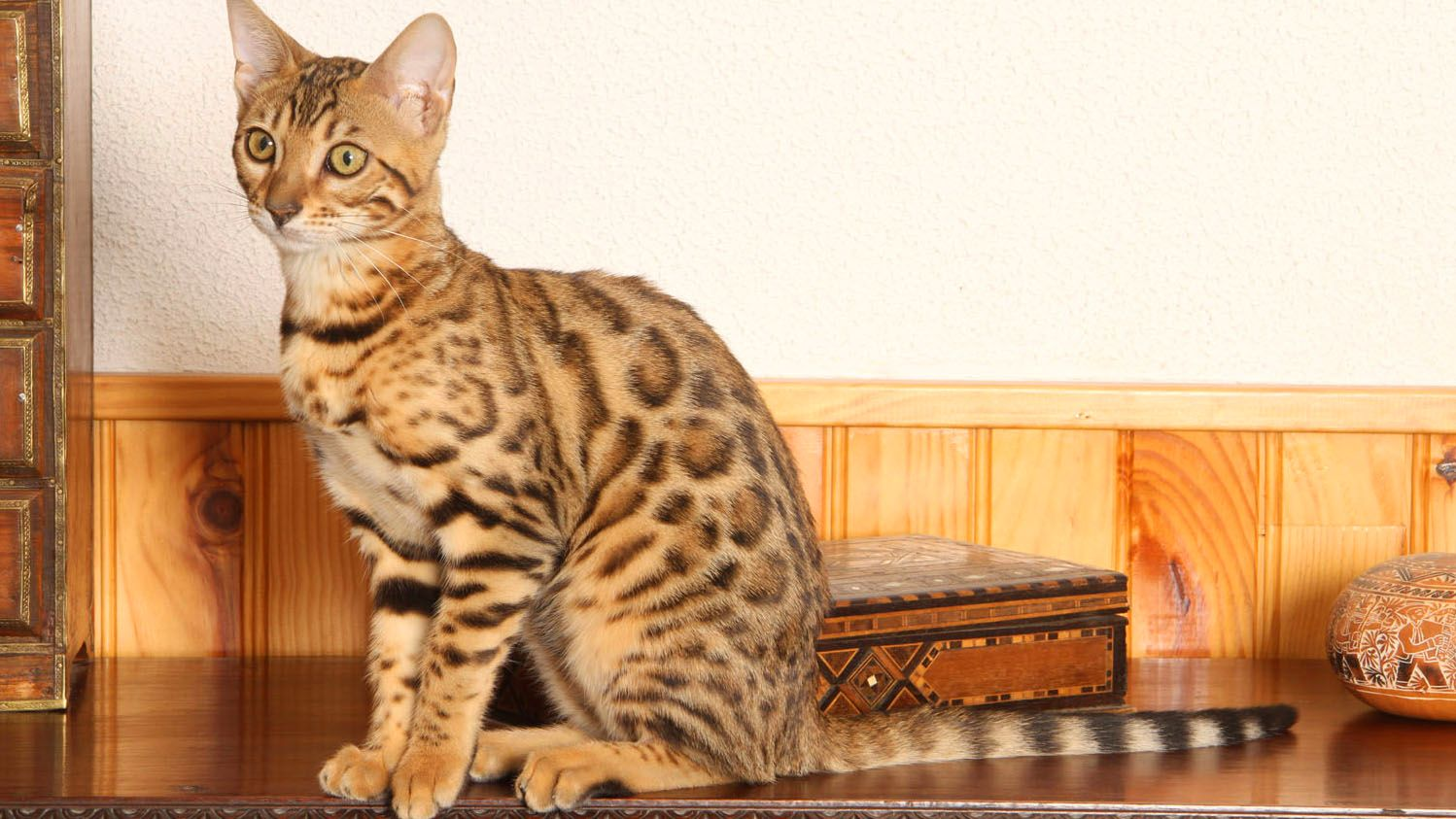
Cuidado del Bengalí
Consejos de cuidados, entrenamiento y ejercicio
Ser medio gato salvaje significa que la agilidad y la fuerza son evidentes en el Bengalí. Es un atleta natural que necesita espacio para deambular en el interior o al aire libre y para seguir sus instintos naturales mientras explora los árboles y arbustos de su dominio doméstico. No lo pierdas de vista cuando esté al aire libre para que no se aleje y se mantenga a salvo de depredadores, tráfico o ladrones, un riesgo para cualquier felino.
Cuidar el impresionante pelaje del gato Bengalí es un placer para cualquiera que acceda al mundo de esta raza tan dinámica. Se trata de un gato relativamente fácil de cuidar, ya que no le prestan demasiada atención. Un cepillado a la semana debería ser suficiente para mantener bajo control la pérdida de pelo, que suele ser reducida. Baña a tu Bengalí con poca frecuencia con el objetivo de preservar mejor su pelaje de bajo mantenimiento. Córtale las uñas una vez al mes para su mantenimiento.
El gato Bengalí es excelente a la hora de aprender trucos y es más fácil de entrenar que muchas otras razas de gatos. Son muy leales a sus propietarios y están encantados de formar parte de un grupo. Se mantienen extremadamente alerta y atentos. Además, ¡son capaces de abrir puertas y armarios con sus garras!
Ser medio gato salvaje significa que la agilidad y la fuerza son evidentes en el Bengalí. Es un atleta natural que necesita espacio para deambular en el interior o al aire libre y para seguir sus instintos naturales mientras explora los árboles y arbustos de su dominio doméstico. No lo pierdas de vista cuando esté al aire libre para que no se aleje y se mantenga a salvo de depredadores, tráfico o ladrones, un riesgo para cualquier felino.
Cuidar el impresionante pelaje del gato Bengalí es un placer para cualquiera que acceda al mundo de esta raza tan dinámica. Se trata de un gato relativamente fácil de cuidar, ya que no le prestan demasiada atención. Un cepillado a la semana debería ser suficiente para mantener bajo control la pérdida de pelo, que suele ser reducida. Baña a tu Bengalí con poca frecuencia con el objetivo de preservar mejor su pelaje de bajo mantenimiento. Córtale las uñas una vez al mes para su mantenimiento.
El gato Bengalí es excelente a la hora de aprender trucos y es más fácil de entrenar que muchas otras razas de gatos. Son muy leales a sus propietarios y están encantados de formar parte de un grupo. Se mantienen extremadamente alerta y atentos. Además, ¡son capaces de abrir puertas y armarios con sus garras!
7/7
Todo sobre el Bengalí
A pesar de haberse criado con un gato leopardo asiático, en la actualidad la raza Bengalí está muy domesticada. Son atletas y gatos tranquilos a partes iguales, además de afables con los niños, una ventaja para las familias en crecimiento. Además, la personalidad del Bengalí es casi como la de un perro: ¡disfrutan asumiendo tareas y aprendiendo trucos!
No, en absoluto. La ferocidad no forma parte de su encanto. Los gatos de esta raza son muy afables y siempre están dispuestos a jugar o simplemente dormir a tu lado. El Bengalí también es conocido por ser excelente con los más pequeños. Atención: el Bengalí tiene un excelente instinto de caza, así que debes mantenerlo alejado del hámster de la familia.
Leer más sobre este tema
Fuentes
- Centros veterinarios de Estados Unidos https://vcahospitals.com/
- Enciclopedia de gatos Royal Canin. Ed. 2010 y 2020
- Hospital de mascotas de Banfield https://www.banfield.com/
- Paquete de productos Royal Canin BHN
Dale like y compartí esta página